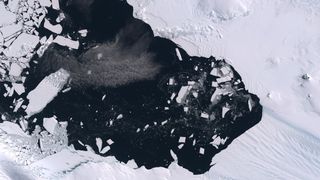
Sea ice breaks up at the mouth of Pine Island glacier in this 2019 image taken by Sentinel-2 satellites.
(Image credit: Getty Images)
Scientists have observed the fastest glacier fracture ever recorded — a crack in Antarctica’s ice that opened at roughly 80 mph (129 km/h).
The finding reveals that giant ice masses can shatter like glass, which could help researchers better understand how climate change will impact ice sheets.
“This is to our knowledge the fastest rift-opening event that’s ever been observed,” Stephanie Olinger, lead author of a new study into the glacier and a geophysicist at Stanford University, said in a statement. “This shows that under certain circumstances, an ice shelf can shatter. It tells us we need to look out for this type of behavior in the future, and it informs how we might go about describing these fractures in large-scale ice sheet models.”
The new study was published Feb. 5 in the journal AGU Advances.
The 6.5-mile-long (10.5 kilometers) rift opened in 2012 on West Antarctica’s Pine Island Glacier, a key ice shelf that acts as a cork for the broader ice sheet, preventing it from sliding into the sea.
Glaciologists define rifts as cracks that pass all the way through a floating ice shelf and are typically seen as precursors to the calving of ice shelves into the ocean.
Related: City-sized holes on Antarctica’s ice shelves offer tantalizing ‘window’ into the frozen continent’s underworld
To study the rift, the researchers combined satellite observations with seismic data taken from instruments on the ice shelf.
At a cursory glance, brittle ice might be expected to shatter, but viscous seawater fills the cracks, which muddies the picture. In the new study, the scientists found that, unlike bigger ice sheets that are breaking apart slowly, the one at Pine Island is indeed shattering.
“Is rift formation more like glass breaking or like Silly Putty being pulled apart? That was the question,” Olinger said. “Our calculations for this event show that it’s a lot more like glass breaking.”The Pine Island Glacier and its southern neighbor, the Thwaites or “‘Doomsday”‘ Glacier, have been in retreat since the 1940s and melting rapidly since the 1980s. Thwaites Glacier’s melt alone has contributed to a 4% rise in global sea levels with the loss of roughly 595 billion tons (540 billion metric tons) of ice, and scientists believe both glaciers may have already crossed key tipping points for collapse.
The Pine Island Glacier has a surface area of roughly 62,660 square miles (162,300 square kilometers), and the Thwaites Glacier is of 74,130 square miles (192,000 square km). If the Thwaites Glacier were to melt completely, it would raise sea levels by more than 2 feet (0.6 meter). If this melt led to the broader destabilization of the West Antarctic Ice Sheet, global sea levels would rise by approximately 11 feet (3.4 m).
“Ice shelves exert a really important stabilizing influence on the rest of the Antarctic ice sheet. If an ice shelf breaks up, the glacier ice behind really speeds up,” Olinger said. “This rifting process is essentially how Antarctic ice shelves calve large icebergs.”
Get the world’s most fascinating discoveries delivered straight to your inbox.
Ben Turner is a U.K. based staff writer at Live Science. He covers physics and astronomy, among other topics like tech and climate change. He graduated from University College London with a degree in particle physics before training as a journalist. When he’s not writing, Ben enjoys reading literature, playing the guitar and embarrassing himself with chess.
>>> Read full article>>>
Copyright for syndicated content belongs to the linked Source : Live Science – https://www.livescience.com/planet-earth/climate-change/fracturing-antarctic-glacier-breaks-80-mph-speed-record
